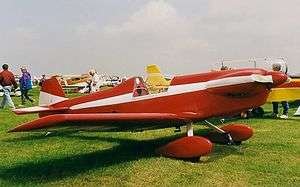Taylor Titch
The Taylor Titch is a British fixed-wing homebuilt aircraft, developed in the 1960s by J.F. Taylor.[1] As of 2015, examples are still being built and flown.[2]
| J.T.2 Titch | |
|---|---|
 | |
| Role | homebuilt aircraft |
| National origin | United Kingdom |
| Designer | John Taylor |
| First flight | 4 January 1967 |
| Status | Plans available (2015) |
| Number built | 40 (2011) |
| Unit cost |
£110 (2015) |
| Developed from | Taylor Monoplane |
Development
.jpg)
Taylor designed the Titch[lower-alpha 1] as an entry in the 1964 Midget Racer Design Competition promoted by Rollason.[3] Among the criteria requested was that it had to be a single-seater powered by a Rollason Ardem flat-four engine, design limits were ±6g, maximum wing area of 65 sq ft and a maximum weight of 750lbs.[3] As a result of Taylor designed a high performance single-seater, the Titch based on his earlier Taylor Monoplane.
At the closing date of the competition 42 designs had been submitted which was won by a project named Beta but the Titch was placed second.[3]
Taylor built the prototype, registered G-ATYO, at Leigh-on-Sea, Essex between 1965 and 1966. The Titch first flew at Southend Airport on 4 January 1967.[4]
The designer John Taylor was killed when the prototype Titch crashed at Southend on 16 May 1967. The marketing of plans for both his aircraft designs were taken on by his wife and later his son.[5]
As of 2011, 40 examples had been completed and flown.[6]
Design
The Titch is a single-seat low-wing cantilever monoplane of all wood construction similar to the Monoplane but has fewer metal fittings than the earlier design and full size wing rib plans are supplied for the tapered wing panels. With a cruise speed in the region of 160 mph (260 km/h), it is an effective cross-country touring aircraft and is also fully aerobatic. Builders can fit it with either a Continental or a Lycoming engine.[4]
Specifications (Prototype)
Data from Jane's All The World's Aircraft 1969-70 [7]
General characteristics
- Crew: 1
- Length: 16 ft 1 1⁄2 in (4.915 m)
- Wingspan: 18 ft 9 in (5.72 m)
- Height: 4 ft 8 in (1.42 m)
- Wing area: 68 sq ft (6.3 m2)
- Empty weight: 500 lb (227 kg)
- Max takeoff weight: 750 lb (340 kg)
- Fuel capacity: 10 imp gal (12 US gal; 45 L)
- Powerplant: 1 × Continental C85-12F Four-cylinder air-cooled horizontally opposed piston, 85 hp (63 kW)
- Propellers: 2-bladed Hegy wooden scimitar propeller, 5 ft 0 in (1.52 m) diameter
Performance
- Maximum speed: 200 mph (320 km/h, 170 kn) [8]
- Cruise speed: 110 mph (180 km/h, 96 kn) (econ. cruise)
- Stall speed: 50 mph (80 km/h, 43 kn) (flaps down)
- Never exceed speed: 225 mph (362 km/h, 196 kn) =[8]
- Rate of climb: 1,100 ft/min (5.6 m/s)
Notes
- Originally called the Tiger Cub
References
Notes
- Air Trails, Winter 1971, p. 78.
- Tacke, Willi; Marino Boric; et al: World Directory of Light Aviation 2015-16, page 129. Flying Pages Europe SARL, 2015. ISSN 1368-485X
- "Midget Racers". Flight International. 24 December 1964. p. 1083.
- Purdy 1998, p. 267.
- Dunnell Aeroplane June 2017, p. 129.
- Bayerl and Berkemeier 2011, p. 122.
- Taylor 1969, p. 227.
- Taylor 1980, p. 499.
Bibliography
- Bayerl, Robby, Martin Berkemeier et al. World Directory of Leisure Aviation 2011–12. Lancaster UK: WDLA UK, 2011. ISSN 1368-485X.
- Dunnell, Ben. "Aeroplane Archive: Taylor Made". Aeroplane, Volume 45, No. 6, June 2017. pp. 127–129. ISSN 0143-7240.
- Jackson, A.J. British Civil Aircraft since 1919, Volume 3. London: Putnam, 1974. ISBN 0-370-10014-X.
- Purdy, Don: AeroCrafter: Homebuilt Aircraft Sourcebook, Fifth Edition. Benicia, California: BAI Communications, 1998. ISBN 978-0-96364-093-2.
- Taylor, John W.R. (ed.) Jane's All The World's Aircraft 1969–70. London: Jane's Yearbooks. 1969.
- Taylor, John W.R. (ed.) Jane's All The World's Aircraft 1980–81. London: Jane's Publishing, 1980. ISBN 0-7106-0705-9.
External links
| Wikimedia Commons has media related to Taylor Titch. |